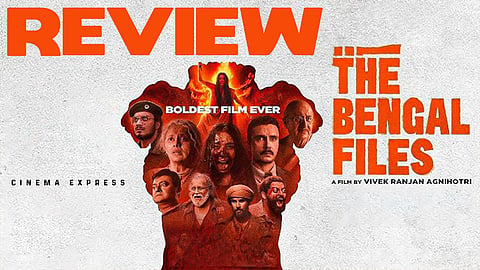The Bengal Files Movie Review: Vivek Agnihotri’s divisive diatribe is a numbing bore
The Bengal Files Movie REview(1 / 5)
Vivek Agnihotri is at it again. With The Bengal Files, the director has come up with another incendiary, divisive and histrionic ‘history’ lesson. This time he turns his investigative lens towards Bengal’s Direct Action Day, the fateful date of August 16, 1946, when All India Muslim League’s demand for Pakistan warped into communal riots in the state. Just like Agnihotri did in The Kashmir Files, nuance is again thrown out of the window. There is no space for sensitivity or sensibility, only sensation. As expected, amidst the ongoing special intensive revision (SIR) of electoral list in Bihar and upcoming Bengal elections, the film reeks of propaganda. The director strives to incite not introspect.
Director: Vivek Ranjan Agnihotri
Cast: Darshan Kumaar, Pallavi Joshi, Anupam Kher, Saswata Chatterjee, Mithun Chakraborty, and Nimashi Chakraborty
In Vivek Agnihotri’s cinematic world (it should be called The Files Universe), a country with currently mere 24 Muslim MLAs in the Lok Sabha, apparently has a ‘system’ in place that favours them. In this world, a Muslim is either a fanatic, an opportunistic politician, or a helpless girl willing to marrying at a young age because how else can you survive the religion’s patriarchy? The director paints everything and everybody in broad brushstrokes, presenting only the facts that further a particular agenda. But then, maybe facts are not facts.
In a similar structure to The Kashmir Files, the film proceeds in two timelines: present day and the 1940s leading up to the Partition. Presently, CBI officer Shiva Pandit (Darshan Kumaar) is tasked with solving a case of a missing Dalit girl Gita. He is sent from Delhi to a district in West Bengal lorded over by Muslim leader Sardar Husseini (Saswata Chatterjee). The cops have caught a suspect, Bharati Banerjee (Pallavi Joshi), a graying woman in a sadhvi’s apparel, suffering from Alzheimer’s. Gita was working at Bharati’s house when she was kidnapped. The 1940s timeline tells Bharati’s story as a young, rebellious girl who shoots at a governor, as a mark of protest against the British Raj. In a preceding scene, her father, a Judge, describes her as being ‘communist’. After being let off in the case as she was a juvenile, Bharati is taken to Gandhi (played by Anupam Kher) to get some perspective. The Mahatma teaches her a thing or two about the futility of violence. How it is a flame that ultimately engulfs everything. Bharati witnesses its horrors on the day of Direct Action, with a mob, led by a fanatic Ghulam Husseini (Namashi Chakraborty) thronging the streets, killing and looting at a whim. It’s no surprise that this mob is predominantly Muslim but Agnihotri attempts at a balancing act and shows the side of Gopal Patha, a Brahmin goat-butcher, who led Hindu mobs in defense against allegedly state-sponsored atrocities. But the director presents it plainly, merely as a reaction without going deep into it.
What the film doesn’t shy away from, however, is gratuitous violence. Men are thrown off balconies more than once, kids are shot in the back, a character who believes in rights and justice has his head is crushed under a manhole cover, another’s body is torn from the middle, yet another is beheaded, a Hindu woman’s clothes are ripped off by a mob of Muslim men. The gore-fest is relentless and unnecessary, executed only to enrage.
Agnihotri frequently suggests that the horrors of the past are still haunting the present. He shows the present-day Muslim MLA Sardar Husseini as just an updated, at-home liberal version of the fanatic Ghulam who was serving death in the streets in 1946. Sardar’s wife might not be wearing a burkha and his son might read Tagore but at his core he is still using division to further his interests. The film frequently suggests that if nobody takes action, Bengal soon might become the ‘next Kashmir’ and that the Partition of India is still, albeit clandestinely, in motion.
Even if you detach the film from its politics (I’ll be amazed if you can) and look at it from a perspective of storytelling and craft, The Bengal Files still falters. At a runtime of 3 hours 20 minutes and with every character going on a tiring tirade, the movie makes for an excruciating experience akin to a bland history lesson. Amidst all the noise, the performances too couldn’t leave a mark and felt perfunctory. The Bengal Files responds to a tragedy with anger. It will leave you disturbed and anguished. It borrows definitive answers for present-day questions from a tainted past. That’s not how we move forward.


